This is one in a series of posts on the Sony alpha 7 R Mark IV (aka a7RIV). You should be able to find all the posts about that camera in the Category List on the right sidebar, below the Articles widget. There’s a drop-down menu there that you can use to get to all the posts in this series; just look for “A7RIV”.
Note: there is little in this post that wasn’t in yesterday’s. I’m just including it for completeness.
Yesterday I plotted some dark-field spectra for the Sony a7RIV. They were from 600×600 pixel crops. Now I’ll show you some spectra from the entire frame.
There is some strangeness at ISO 50:
The horizontal axis is the frequency, with 0.5 being the Nyquist frequency for the sensor. The vertical axis is the frequency response in decibels. Plane 1 is the raw red plane, Plane 2 is the first green plane, plane 3 is the second green plane, anad plane 4 is the blue plane. I have no idea what’s causing those undulations in the first three planes. It’s obvious that there is about 1 dB worth of low pass filtering in all the planes. The spike at 1/3 the sampling frequency in the horizontal direction for the blue plane might indicate something about the PDAF pixel spacing. That would be every sixth pixel in the entire raw file.
The undulations go away at ISO 100, but we see the same kind of spectra otherwise:
The undulations reappear at ISO 160:
The spike in the blue plane, which had been getting smaller as the ISO went up, is gone by ISO 200:
We get undulations again at ISO 400, but only in one plane:
At ISO 500, we see the waviness in two planes:
By ISO 1250, the low-pass filtering which has been diminishing with increasing ISO, has all but gone away:
Except in the blue plane, but it’s much lower even there:
By ISO 4000, the difference in the frequency response of the blue plane and the others has started to grow again:
By ISO 12800, the last ISO without an extra dollop of low-pass filtering in all channels the difference is striking:
By ISO 25600, the lowpass filtering is quite apparent, and we have a spike int he blue channel at 1/(3 * plane’s pitch).
There’s a lot of processing going on here.
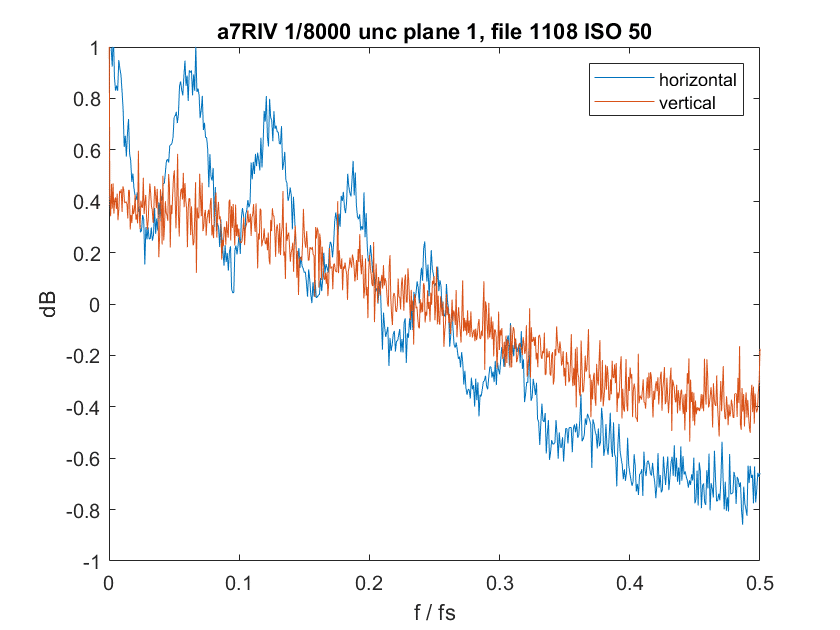
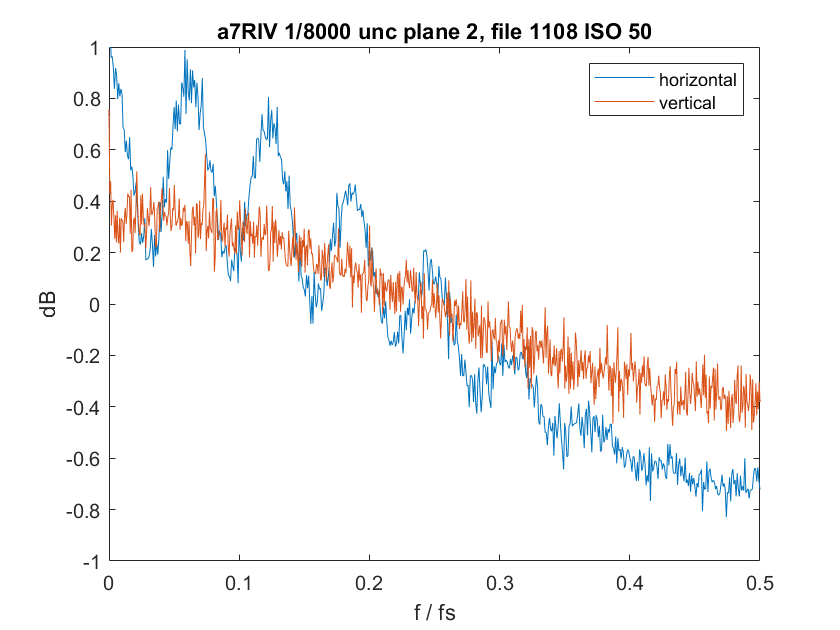
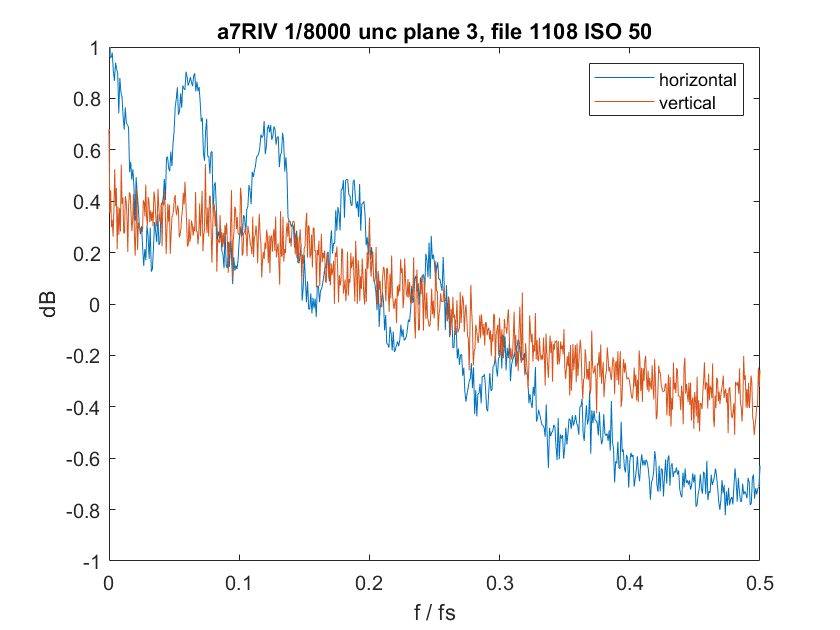
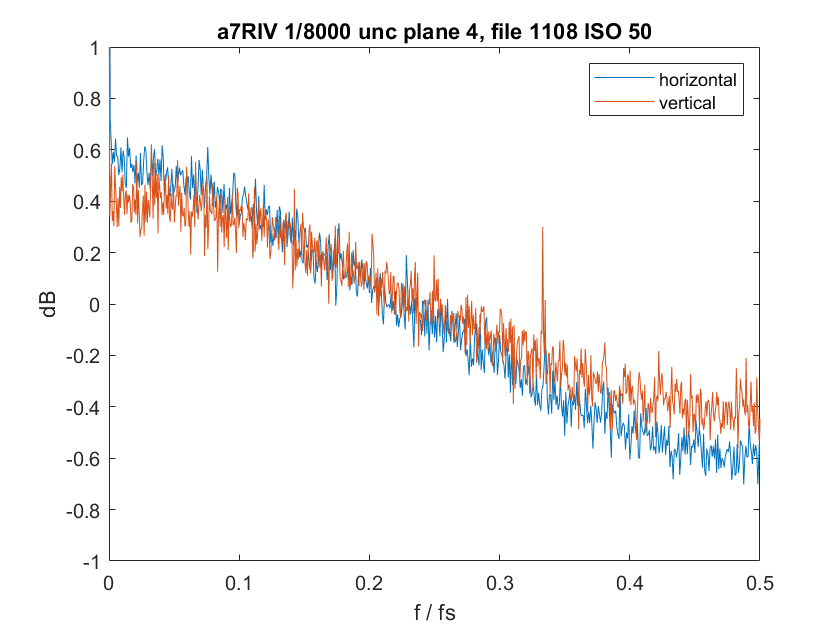
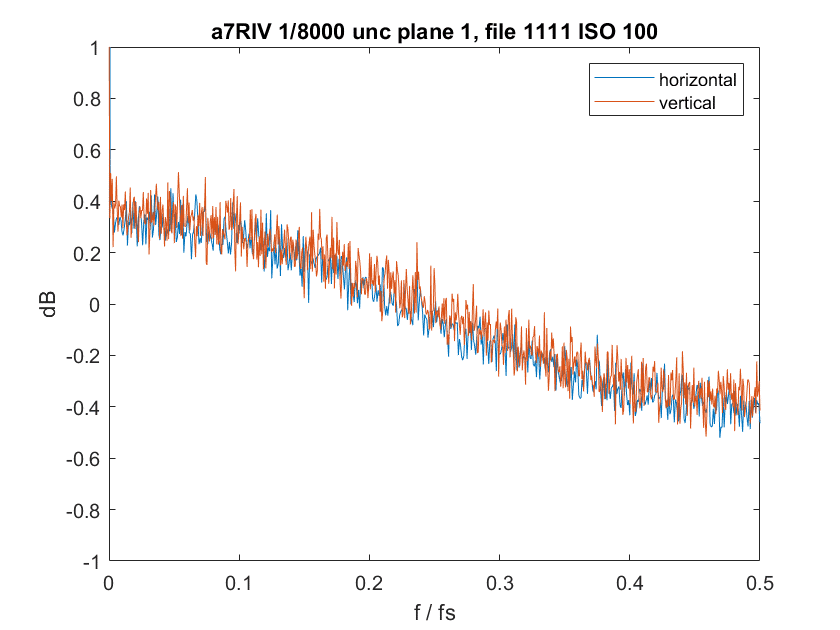
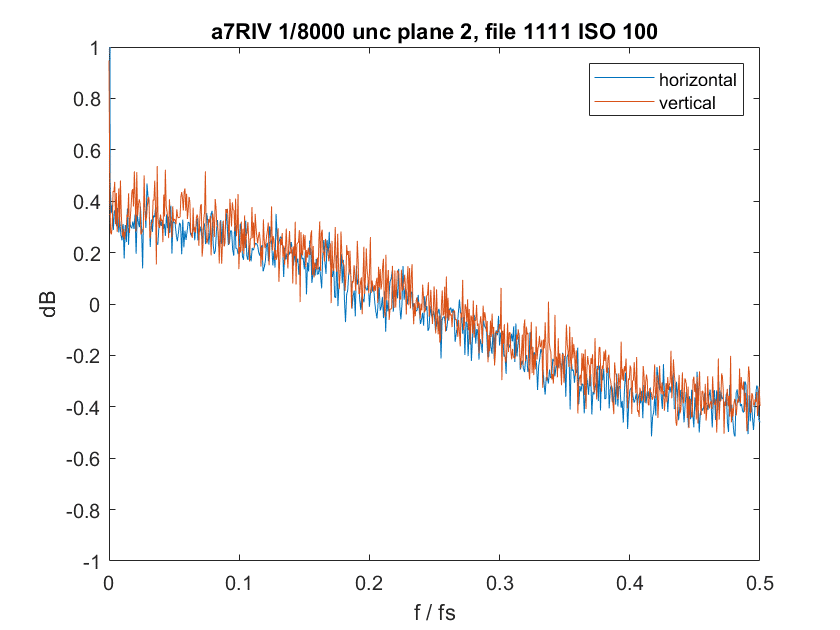
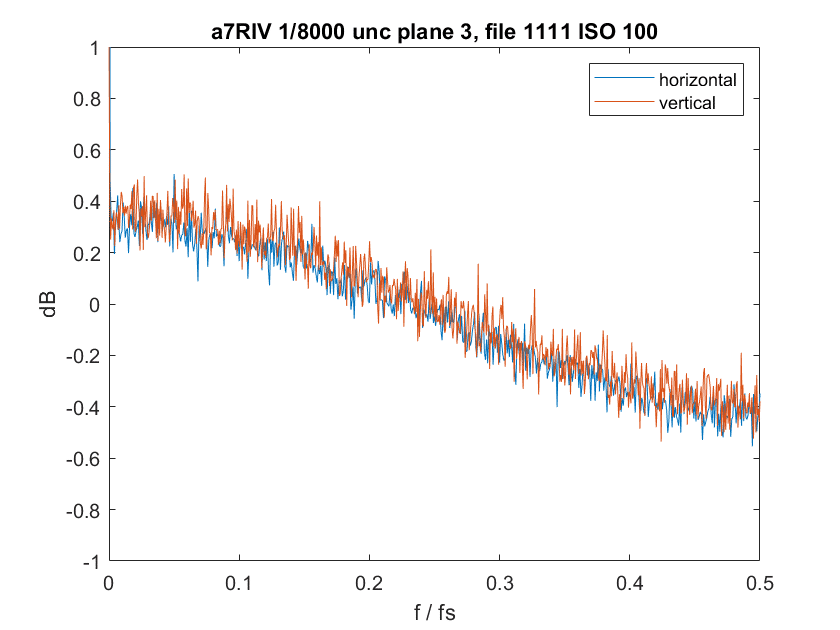
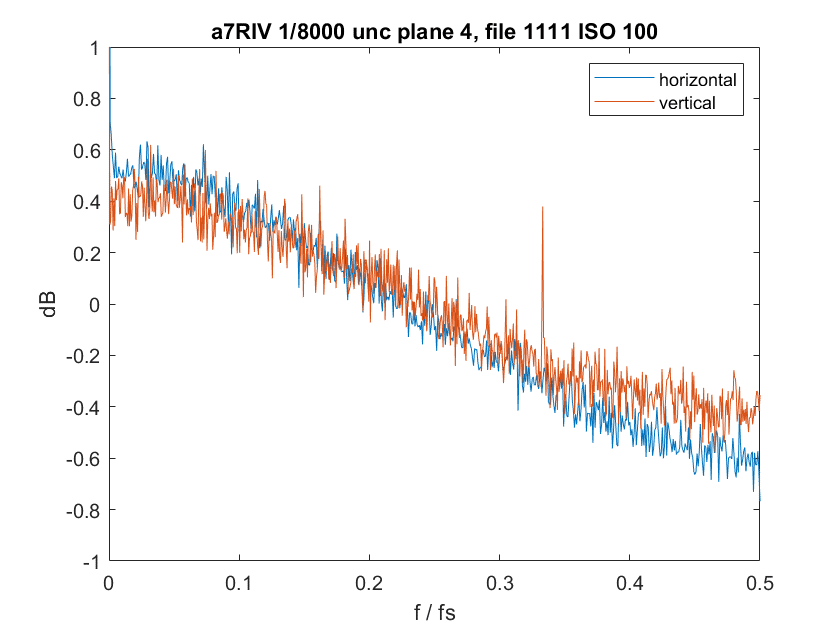
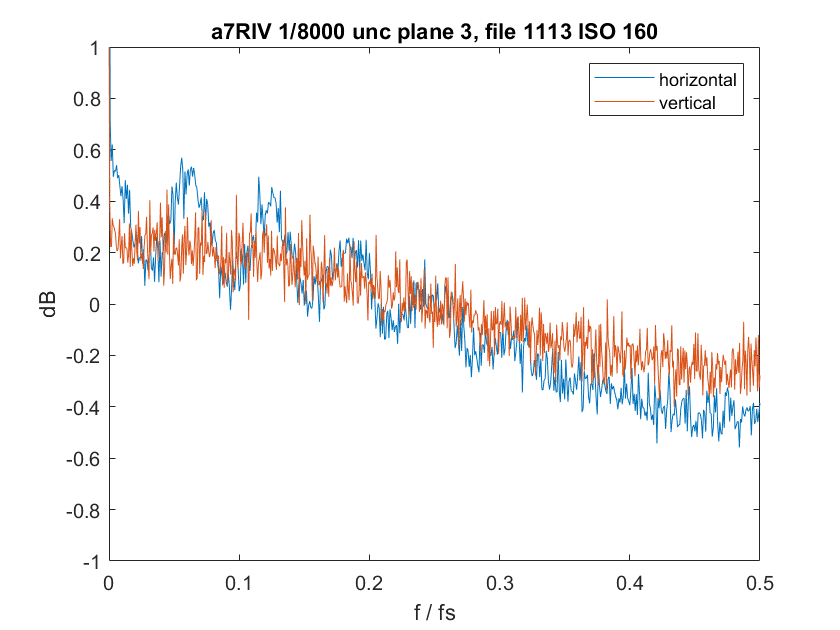
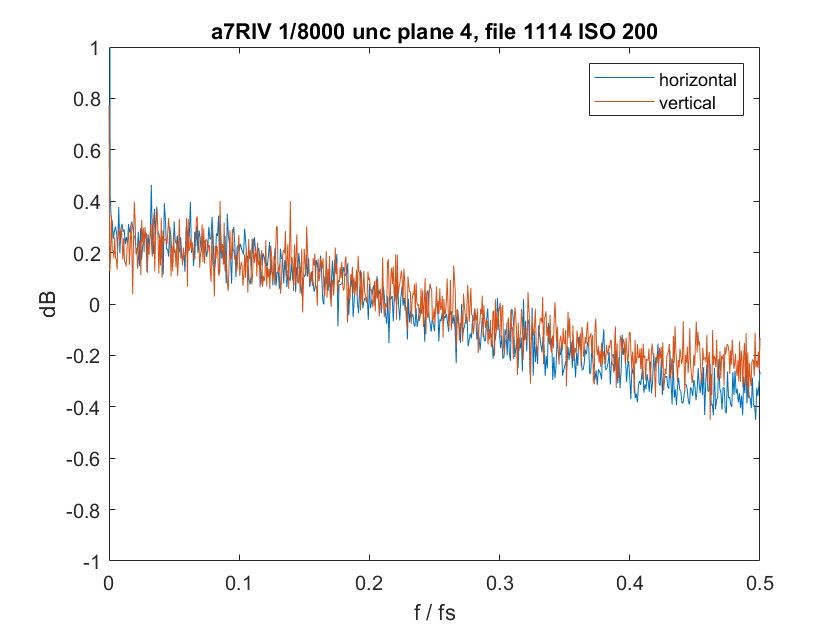
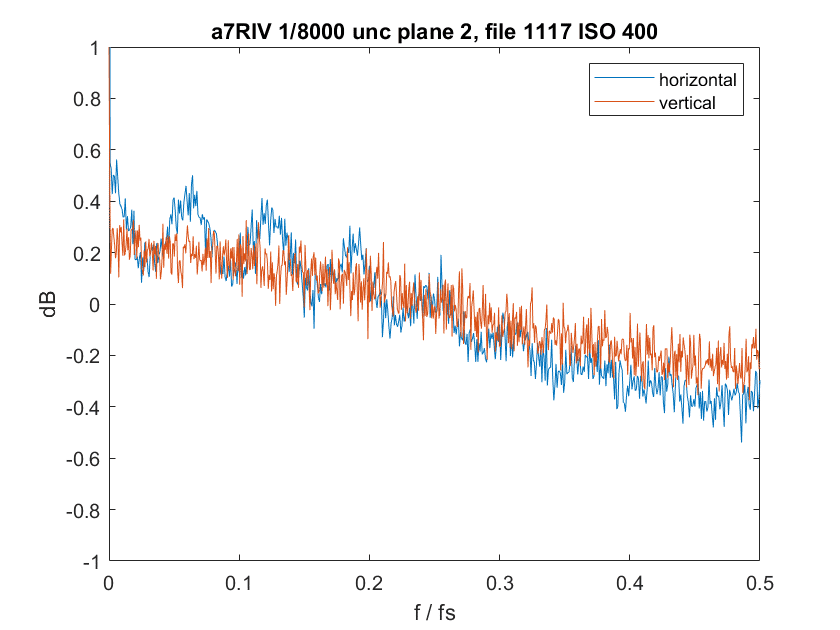
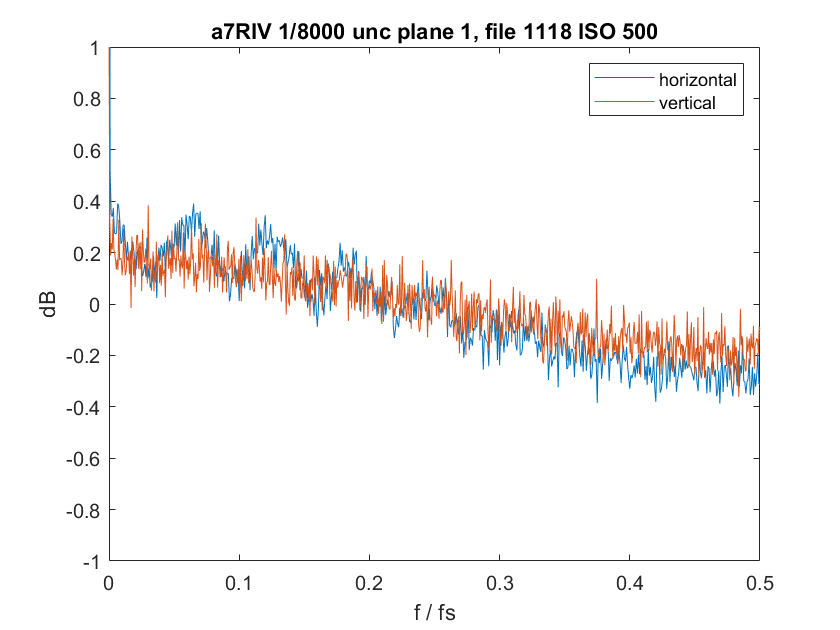
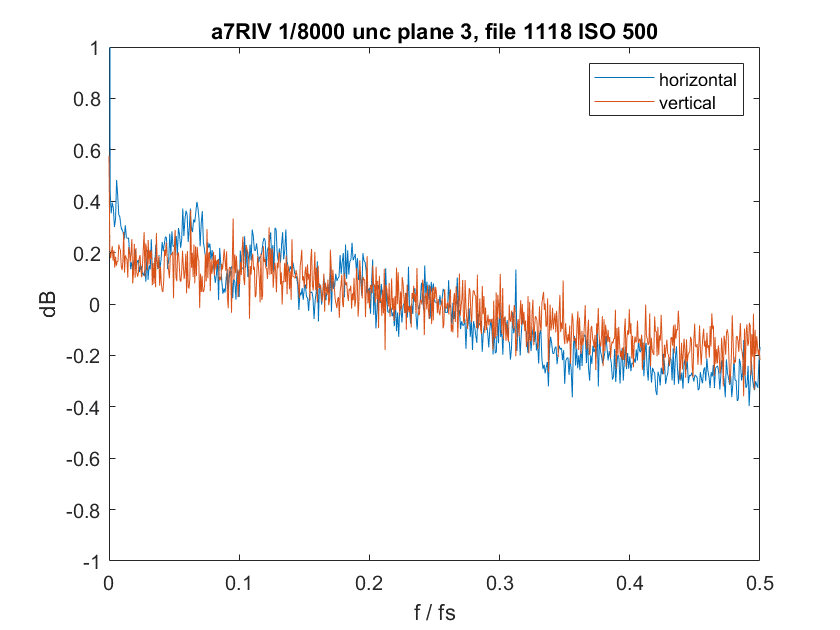
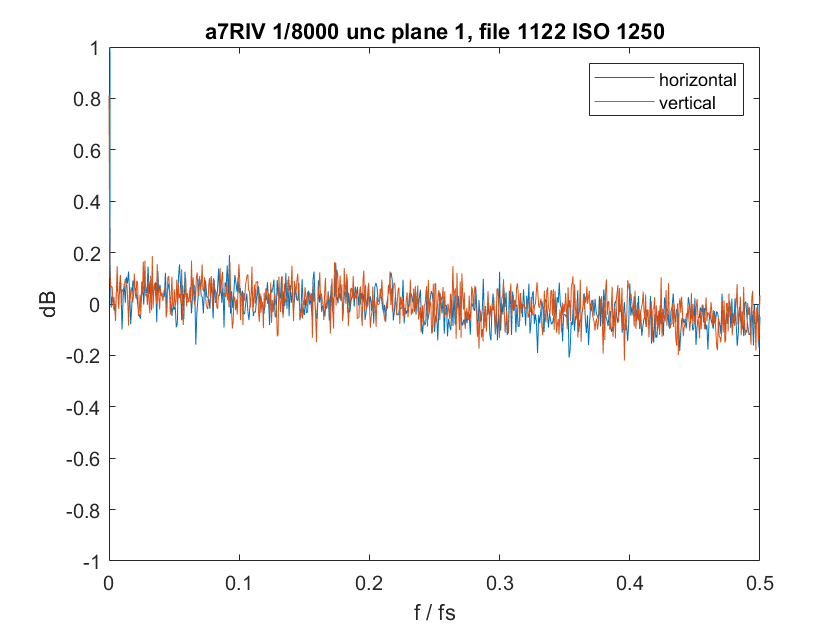
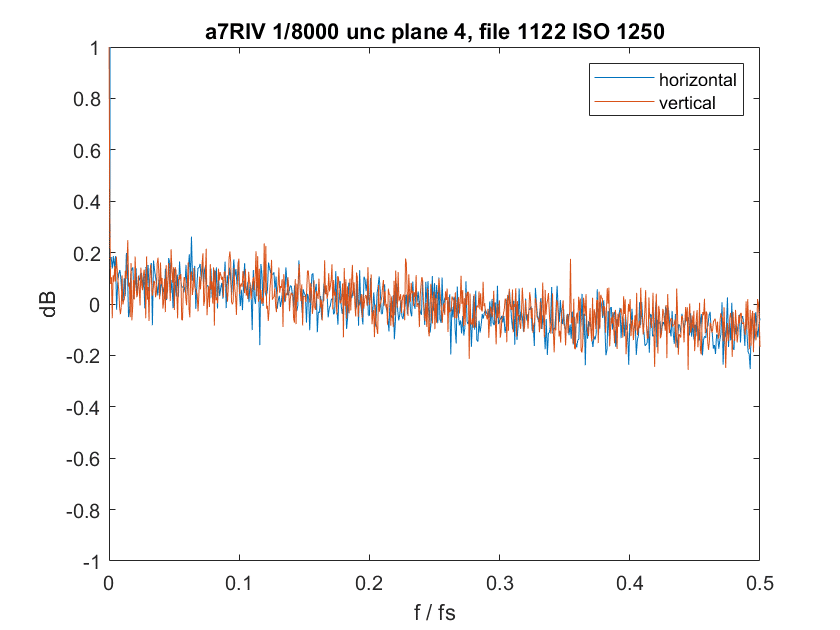
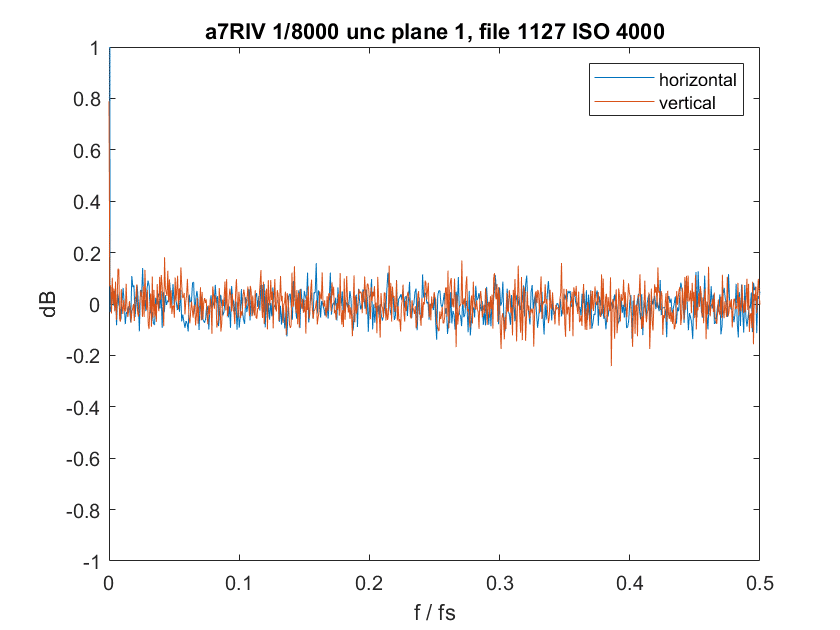
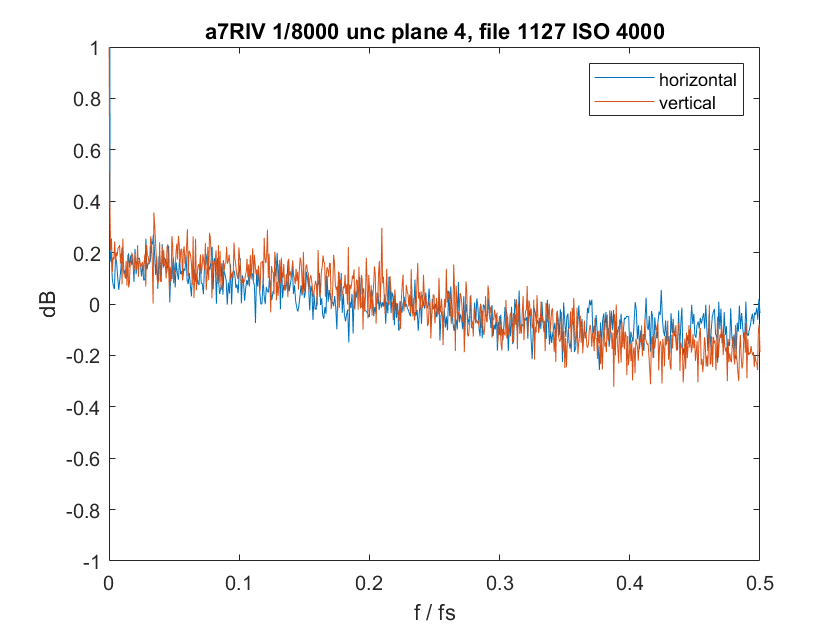
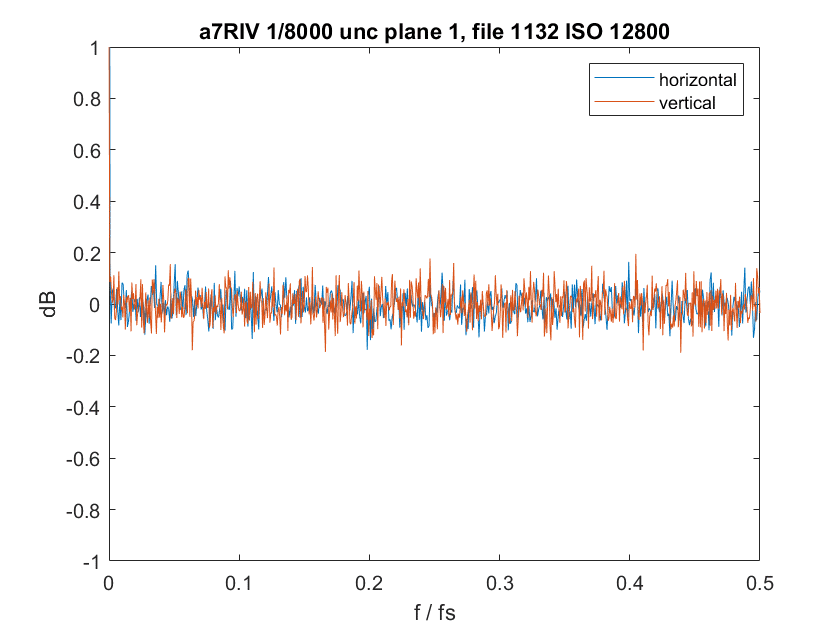
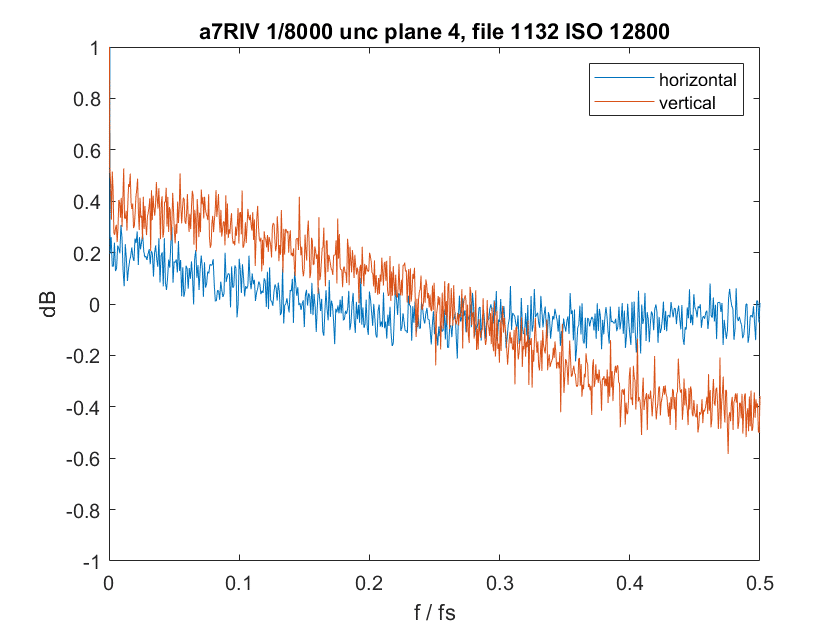
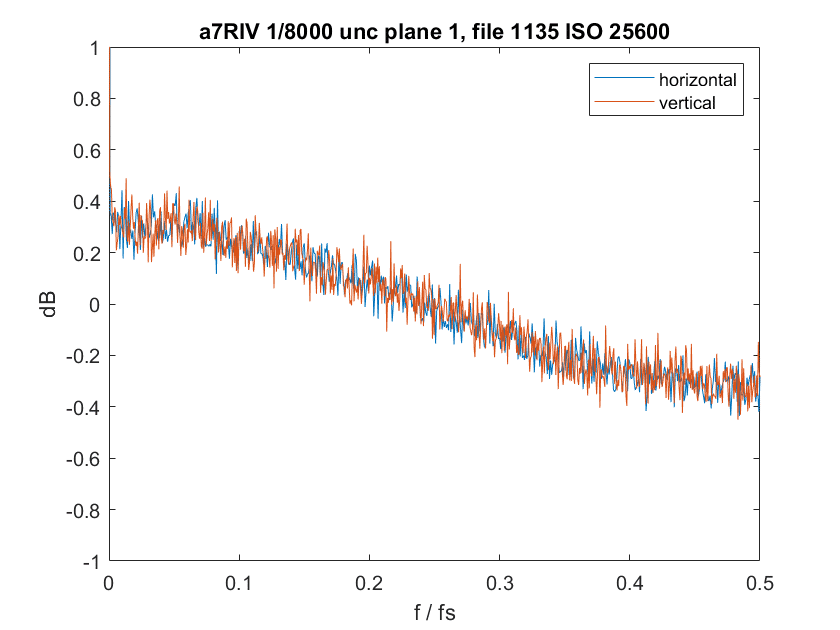
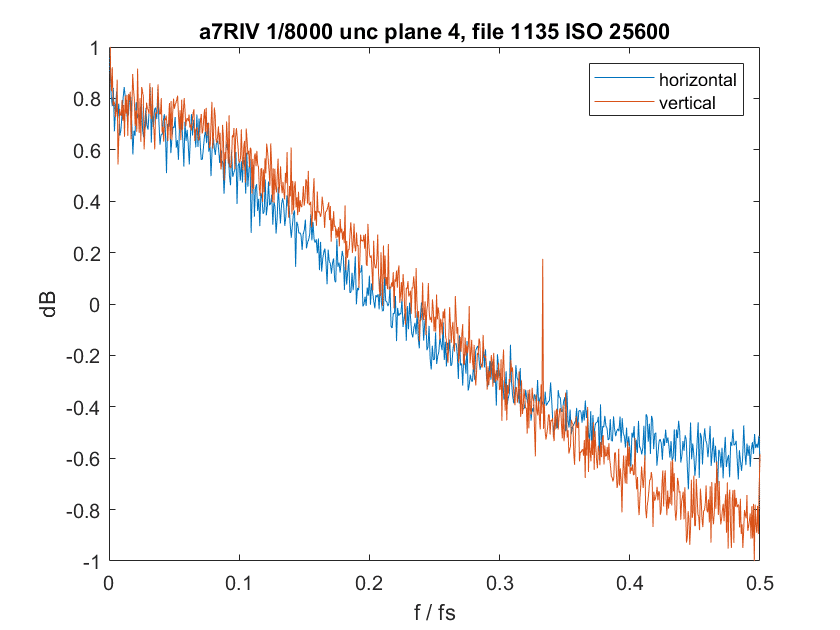
Hi Jim,
This is partially off-topic to this post of yours, but still partially related. I plan to buy an A7R Mark 4, and will eventually be able to empirically answer my own questions, but I’d be interested in your thoughts on the following.
One of the uses to which it’ll eventually be put is digitizing with maximum quality, minimum loss, some old 35mm film images (b&w negatives, color slides and negatives). I’ll be using a good quality macro lens (probably the Sony 90mm, though I might consider the Apo-Lanthar 110mm; I don’t yet have either). Obviously, in such use I can control illumination intensity, so can choose optimum ISO.
For digitization of the b&w negatives, I’m considering using one of the pixel-shift modes in combination with a band-limited illuminant, and then using just the blue or green channel image. On the positive side of the ledger, that theoretically gets rid of much of whatever chromatic aberration might be present, and the shorter wavelength should also boost resolution. On the negative side, a band-limited image may make any artifacts from aspheric lens elements or grain aliasing more visible. Indeterminant positive or negative will be any imprecision in the pixel-shift mechanism, which might reduce resolution but also reduce the above-mentioned adverse effects. (I’m probably over-thinking the whole thing 🙂
I don’t expect sensor or system dynamic range to be a problem when digitizing film, but still, do you think any of the sensor structures (i.e. the phase-detect pixels, or anything else) will intrude if I’m only making use of the blue or green channel for b&w film digitization? Do you think that there will be any net benefits to be seen by using just the blue or one/both green color channel(s)?
Thanks for all the testing and analysis you do.
I’ll need to get my hands on an a7RIV before I can comment on pattern noise, banding, and the like. On the other issues, I think you have things well figured out. Are you digitizing chromes or negatives? The dynamic range requirements of the two are strikingly different.
I’ll be doing both negatives and slides. Mostly silver-based black & white negatives, a few color negatives. But I do also have a fair number of color slides.
Yes, I realize that the slope of film density as a function of exposure for slides is much greater than for negatives (except perhaps specialized high-contrast materials like Kodalith), so that for an equivalent exposure range, the density range on slides will be much greater than for negatives.
I haven’t done any formal film densitometry, but looking at film sensitometric curves (Fuji Velvia 50 slides and Neopan Acros 100 as examples), it looks like there’s a density range of ~2.7 for the usable parts of the Velvia curve (before the color curves separate in the shoulder, or contrast reduces too much in the toe). The same exposure range (~1.62 log units) that would produce that ~2.7 density range on Velvia will result in a density range of only ~1.0-1.2 (depending on whether one was developing for condenser or diffusion enlargement) on the Acros 100 b&w negatives. And even a much greater (but realistic) exposure range, which b&w continuous-tone film can accommodate before shouldering, would be expected to have a smaller density range than that ~2.7 value for Velvia.
So, there’s a multi-stop difference in density ranges between slides and b&w negatives. I don’t expect any problems digitizing negatives — unless some sensor or processing artifact rears its head and somehow becomes unduly prominent if I use just one of the color planes when digitizing monochrome. Color slides might be a different story, especially if flare from light transmission through large low-density areas of a slide happens to interact with sensor structures to generate banding or other artifacts. I guess I’ll find out when I get the A7R4 and a good macro and get around to trying it out for such an application, unless someone beats me to the punch.
You might consider multi shot captures at different exposures and combining in post if DR is an issue. That won’t help with lens flare, though (that points up a strength of a drum scanner, and, to a lesser extent, of a line scanner with baffles).
Thanks for the HDR suggestion, Jim. And good point about that advantage of drum or possibly line scanning, a point I hadn’t previously realized.
Hey Jim,
Love your analysis, even if some of itis above my pay grade haha.
When you do receive your A7IV, please try to assess (or maybe you can comment now) Sony’s known “Star Eater” problem that has plagued night sky photographers saddled with Sony cameras recently. Your comment about processing on the RAWs has me worried.
Thanks and keep up the good work.
I have a request in for a dark-field shutter speed series at ISO 1000. When — and if — I get that, I will be able to comment on the a7RIV’s appetite for stars. Otherwise, I’ll have to wait for my camera to come.
Hi Jim,
I heard the a7RIV using the IMX455 image sensor featured 2×1 OCL (On-Clip Lens) PDAF to increase low light performance. Is it possible that the 2×1 OCL can avoid PDAF banding?
Link:
https://www.techinsights.com/blog/part-4-non-bayer-cfa-phase-detection-autofocus-pdaf
http://www.imagesensors.org/Past%20Workshops/2015%20Workshop/2015%20Papers/Sessions/Session_1/1-04_Yokogawa_033.pdf
I don’t know. We’ll find out next month, I hope.